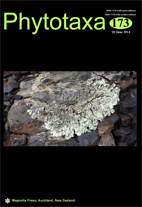Abstract
The family Schistochilaceae Buch (1928: 9) consists of approximately 80 extant species. More than two-thirds of its diversity occurs in temperate to subantarctic South America and Australasia, and nearly one third in the tropical mountain forests of Southeast Asia and the western Pacific Islands. The plants of Schistochilaceae are usually robust and form a prominent component of the ground layer of cool temperate forests or upper montane tropical forests, commonly forests in which Nothofagus is a dominant genus. The first species of the family, published as Jungermannia appendiculata Hooker (1818: tab. 15), Jungermannia glaucescens Hooker (1818: tab. 39), Jungermannia lamellata Hooker (1818: tab. 49), Jungermannia nobilis Hooker (1818: tab. 11), Jungermannia sphagnoides Schwägrichen (1814: 23) and Jungermannia thouarsii Hooker (1818: tab. 48), were described during 1814–1818. Dumortier established the genus Schistochila Dumortier (1835: 15) to accommodate the above mentioned species except Jungermannia glaucescens and Jungermannia sphagnoides, but he also added one new species, Schistochila pinnatifolia Dumortier (1835: 15) nom. inval. (ICN Art. 38.1(a); no description; McNeill et al. 2012). The definition of Schistochilaceae has remained largely unchanged since it was separated from Scapaniaceae Migula (1904: 479) by Buch (1928) and then later Balantiopsaceae Buch (1955: 23). The presence of magenta rhizoids, winged and complicate-bilobed leaves with smaller dorsal lobes, a shoot calyptra elaborated into a well-developed coelocaule, and a cylindrical sporophyte capsule with straight valves generally defines the family. These features, to a great extent, isolate Schistochilaceae from the rest of the leafy liverworts. Therefore, taxonomic rearrangements or revisions, based on morphological investigations, have mostly been at generic level or below (Grolle 1966, 1968, Hässel 1973, Schuster 1971a, Schuster & Engel 1977, 1985). So far, taxonomic revisions have only been done at regional scales, a study at global scale is under way (Glenny et al., unpublished).

